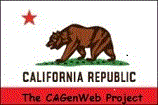 |
 |

|
Maidu, Nisenan and Oustemah People
of Nevada County
by Maria Brower
![]()
American Indian tribes occupied the land that would become the State of California, and Nevada County, for thousands of years prior to the arrival of the first Euro-American explorers. Unlike tribes in other parts of North America, the American Indians living within the this large area had many advantages: a moderate climate, rich soil, an abundance of waterways--both inland and along the Pacific Coast--to fish, and plenty of wildlife to hunt. These natives were a peaceful people at the time of contact, made up of many tribes and language groups. Due to their peaceful nature they were easily taken advantage of and misunderstood for thier gentle nature and simple lifestyle.
The Native Americans that occupied Nevada County were the Nisenan. The Nisenan were located in the middle of gold country, and the impact of the Gold Rush was greater than on any other California tribe. Their peaceful lifestyle changed overnight and was nearly obliterated by the ever-increasing hordes of miners seeking gold. The indigenous people in the area that became Nevada City, the county seat of Nevada County, gave themselves a new name, the "Oustomah" meaning near the town. Little remains in Nevada County to remind us of the people who once had towns throughout Nevada County. The Nisenan have no written record of their past. What is unique to these people is they have no memory or tradition of coming from some other place. Historians and archeologists believe the Nisenan to have inhabited this region for thousands of years. The Nisenan identified one another by family tie or through the names of their village site. Upon the arrival of the non-native settlers, they were known as "Diggers," a name which covered a large portion of Indians of California. In 1877, Stephen Powers published a book, "Tribes of California," and the tribes and bands of Indians were given more fitting names. The name "Nisenan" or sometimes "Nishenam" means "from among us" or "one of us". The Nisenan language had several dialects and it is said that the last official "Chief" of the Nevada City Indians, Chief Louis Kelly, knew 8 Nisenan dialects.
It was impossible to know the number of American Indians that inhabited the area prior to the Gold Rush. Even after that time, a few white men tired to learn thier native language, and none of the Indians could speak English, although some could converse in Spanish.
The numbers estimated at various dates vary greatly. One figure suggests there were 150,000 in all of California in 1848 prior to the gold discovery. It is estimated that in 1769 prior to the first permanent European settlement in California, the native population was 350,000. It was noted by Indian Agent W.P. Crenshaw, in a repot to the superintendent of Indian Affairs in 1854, that one of the problems of ascertaining thier exact number arises from the fact that they were frequently changing camps from one section to another.
Unfortunately, the non-indigenous population brought diseases to which the American Indians had no immunity, and their population was decimated. Diseases such as smallpox, against which American Indians did not have immunity, were responsible for a majority of deaths among the native population. Other leading causes of death were starvation and murder. The population explosion of miners and settlers had a devastating impact on the local environment. Rivers were muddied from mining, herds of game were whipped out, oak trees which provided the main staple of food for the Nisenan, the acorn, were logged and cleared. Surviving Indians were forcibly removed in several attempts to relocate them but were not very successful. The conditions on these reservations were very bad and most Nevada County Indians eventually found their way back home.
Two helpful links are:
Native American Resources at Rootsweb
and
Native American Resources at Cyndi's List
To add more links to this page, please contact the WebMaster with the correct URL and a full description of the content to be linked to.
If you have books covering these topics, especially the California and western tribes and nations, and are willing to do short look-ups, please send your complete name, e-mail address, title, author, publisher and publishing date, to the Webmaster
![]()
Please report broken links to the
Webmaster
This page last updated: 16 Jan 2019
This Web Page is sponsored by the USGenWeb Project in California, CAGenWeb.
© 1996 - 2019 ~ ALL RIGHTS RESERVED, Coordinator, Nevada County, CAGenWeb
Copyright pertains to all photos, graphics, web design, and the compilation and formatting of data extracted from historic records--
except for narrative and compilations written and performed by others as specifically noted herein.